Analysis of CliniCloud Australia's Business Model: A Detailed Report
VerifiedAdded on 2023/01/17
|17
|2890
|68
Report
AI Summary
This report provides a detailed deconstruction of the business model of CliniCloud Australia, a healthcare startup. The analysis utilizes the business model canvas to examine the company's customer segments, value propositions, key activities, channels, revenue streams, cost structure, key resources, and customer relationships. The report highlights the company's innovative approach to healthcare, including its development of smart medical devices like a digital stethoscope and non-contact thermometer. It also discusses the company's key partners, critical success factors, and potential downside risks, such as the need for increased reliability and addressing regulatory issues. The report concludes with recommendations for CliniCloud Australia, including developing training sessions, establishing a strong legal framework, and employing innovative marketing strategies to expand its consumer base and ensure future growth. The report also discusses interrelationships and business model changes. The analysis draws on publicly available information to provide a comprehensive overview of the company's operations and strategic positioning.
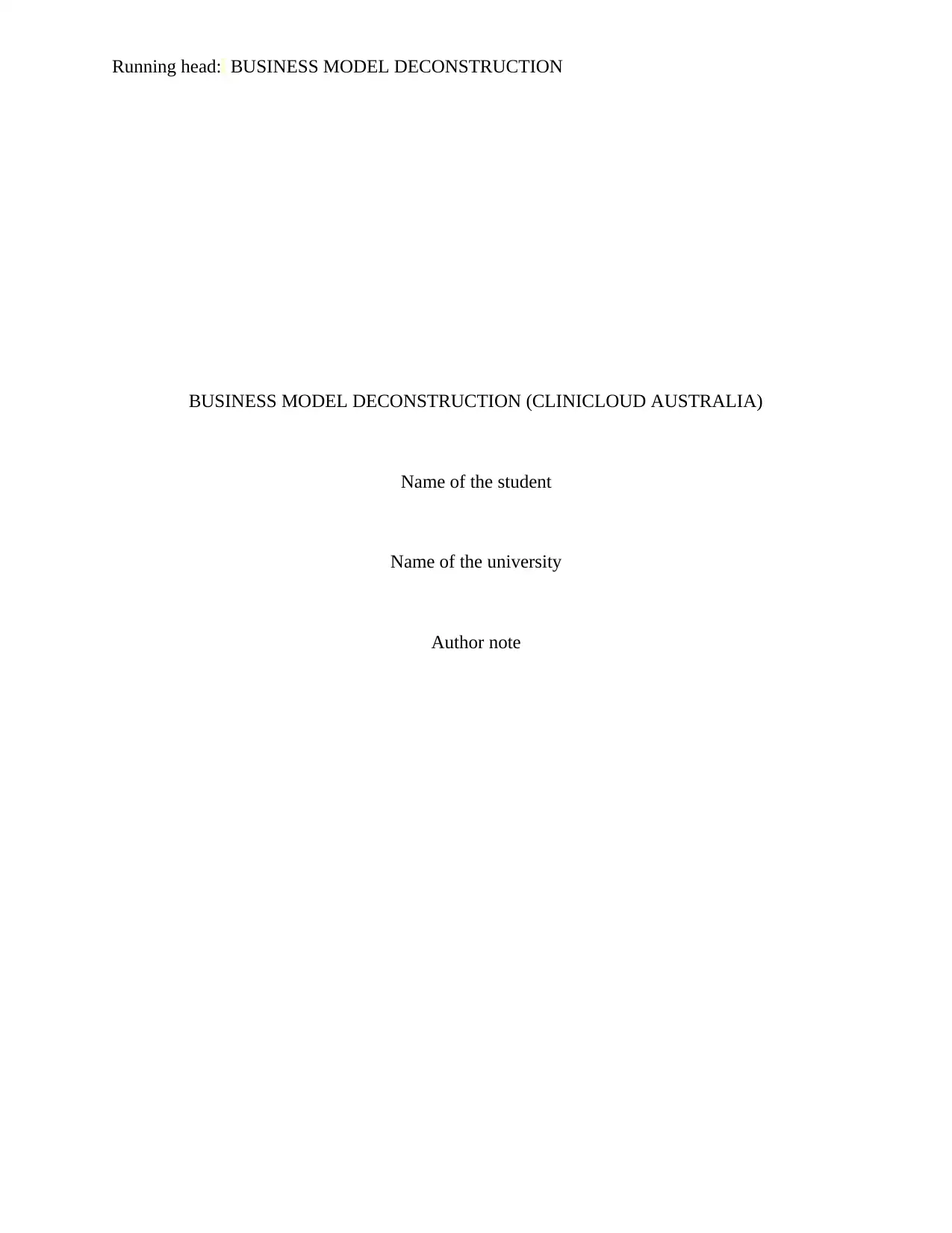
Running head: BUSINESS MODEL DECONSTRUCTION
BUSINESS MODEL DECONSTRUCTION (CLINICLOUD AUSTRALIA)
Name of the student
Name of the university
Author note
BUSINESS MODEL DECONSTRUCTION (CLINICLOUD AUSTRALIA)
Name of the student
Name of the university
Author note
Paraphrase This Document
Need a fresh take? Get an instant paraphrase of this document with our AI Paraphraser
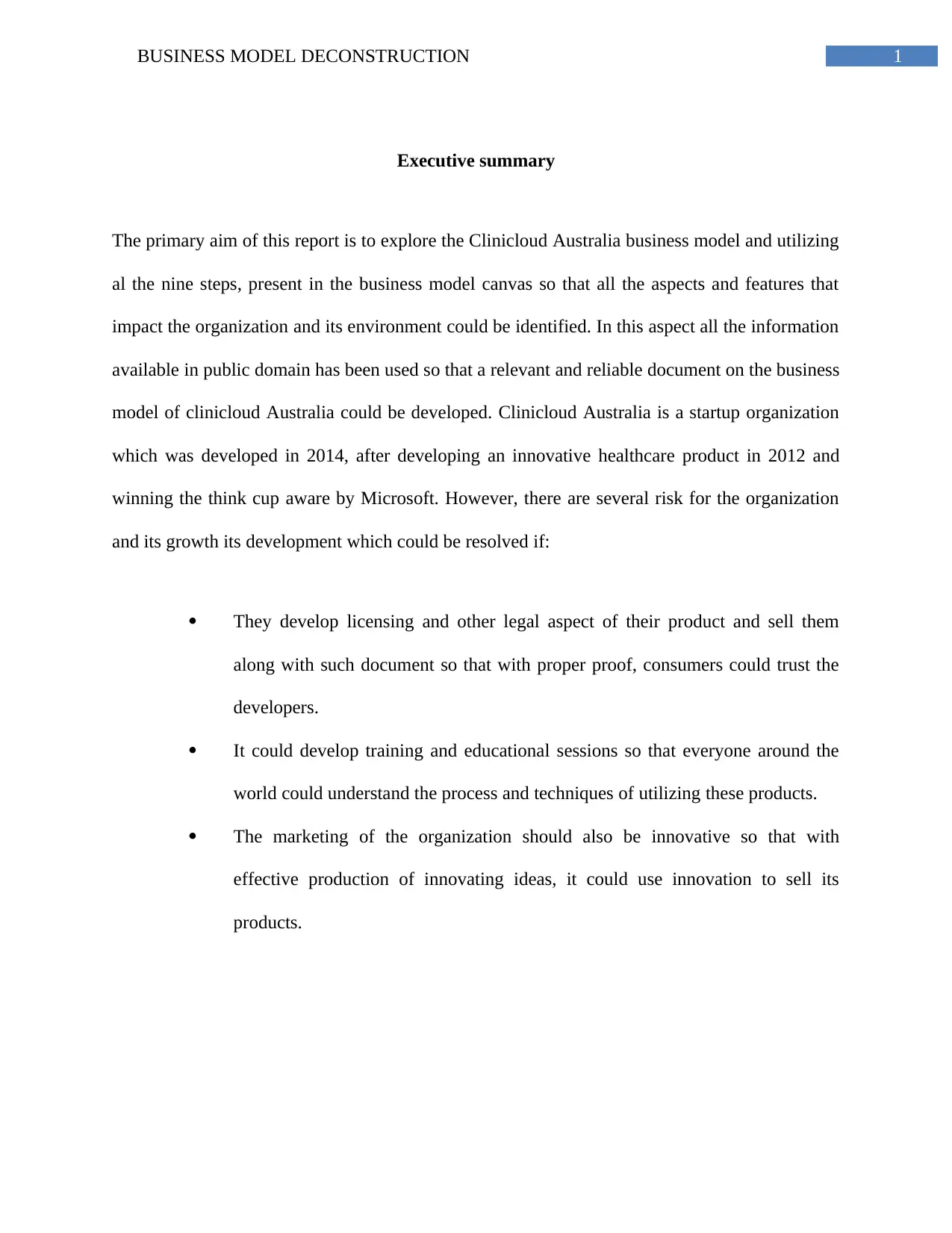
1BUSINESS MODEL DECONSTRUCTION
Executive summary
The primary aim of this report is to explore the Clinicloud Australia business model and utilizing
al the nine steps, present in the business model canvas so that all the aspects and features that
impact the organization and its environment could be identified. In this aspect all the information
available in public domain has been used so that a relevant and reliable document on the business
model of clinicloud Australia could be developed. Clinicloud Australia is a startup organization
which was developed in 2014, after developing an innovative healthcare product in 2012 and
winning the think cup aware by Microsoft. However, there are several risk for the organization
and its growth its development which could be resolved if:
They develop licensing and other legal aspect of their product and sell them
along with such document so that with proper proof, consumers could trust the
developers.
It could develop training and educational sessions so that everyone around the
world could understand the process and techniques of utilizing these products.
The marketing of the organization should also be innovative so that with
effective production of innovating ideas, it could use innovation to sell its
products.
Executive summary
The primary aim of this report is to explore the Clinicloud Australia business model and utilizing
al the nine steps, present in the business model canvas so that all the aspects and features that
impact the organization and its environment could be identified. In this aspect all the information
available in public domain has been used so that a relevant and reliable document on the business
model of clinicloud Australia could be developed. Clinicloud Australia is a startup organization
which was developed in 2014, after developing an innovative healthcare product in 2012 and
winning the think cup aware by Microsoft. However, there are several risk for the organization
and its growth its development which could be resolved if:
They develop licensing and other legal aspect of their product and sell them
along with such document so that with proper proof, consumers could trust the
developers.
It could develop training and educational sessions so that everyone around the
world could understand the process and techniques of utilizing these products.
The marketing of the organization should also be innovative so that with
effective production of innovating ideas, it could use innovation to sell its
products.
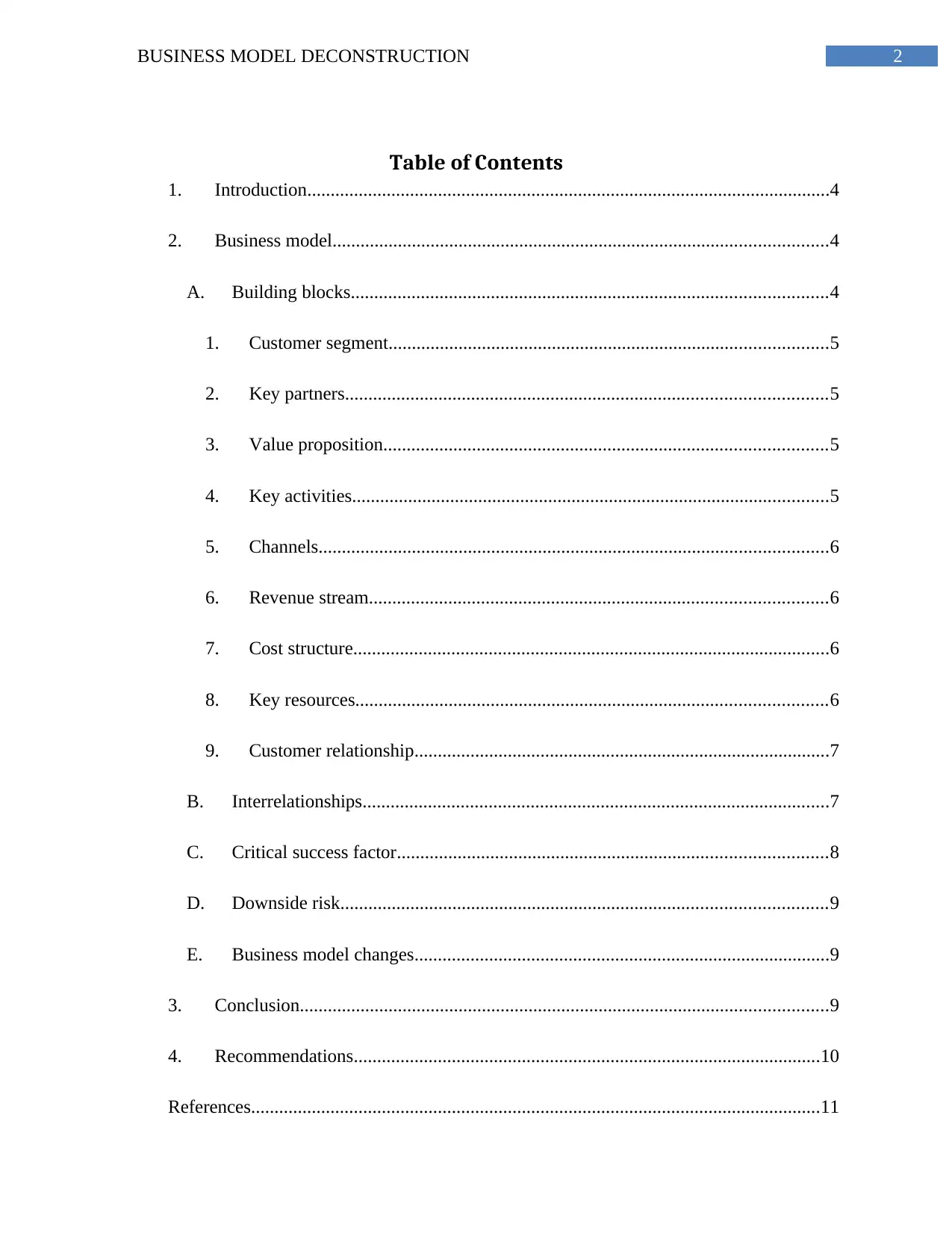
2BUSINESS MODEL DECONSTRUCTION
Table of Contents
1. Introduction................................................................................................................4
2. Business model..........................................................................................................4
A. Building blocks......................................................................................................4
1. Customer segment..............................................................................................5
2. Key partners.......................................................................................................5
3. Value proposition...............................................................................................5
4. Key activities......................................................................................................5
5. Channels.............................................................................................................6
6. Revenue stream..................................................................................................6
7. Cost structure......................................................................................................6
8. Key resources.....................................................................................................6
9. Customer relationship.........................................................................................7
B. Interrelationships....................................................................................................7
C. Critical success factor............................................................................................8
D. Downside risk........................................................................................................9
E. Business model changes.........................................................................................9
3. Conclusion.................................................................................................................9
4. Recommendations....................................................................................................10
References..........................................................................................................................11
Table of Contents
1. Introduction................................................................................................................4
2. Business model..........................................................................................................4
A. Building blocks......................................................................................................4
1. Customer segment..............................................................................................5
2. Key partners.......................................................................................................5
3. Value proposition...............................................................................................5
4. Key activities......................................................................................................5
5. Channels.............................................................................................................6
6. Revenue stream..................................................................................................6
7. Cost structure......................................................................................................6
8. Key resources.....................................................................................................6
9. Customer relationship.........................................................................................7
B. Interrelationships....................................................................................................7
C. Critical success factor............................................................................................8
D. Downside risk........................................................................................................9
E. Business model changes.........................................................................................9
3. Conclusion.................................................................................................................9
4. Recommendations....................................................................................................10
References..........................................................................................................................11
⊘ This is a preview!⊘
Do you want full access?
Subscribe today to unlock all pages.

Trusted by 1+ million students worldwide
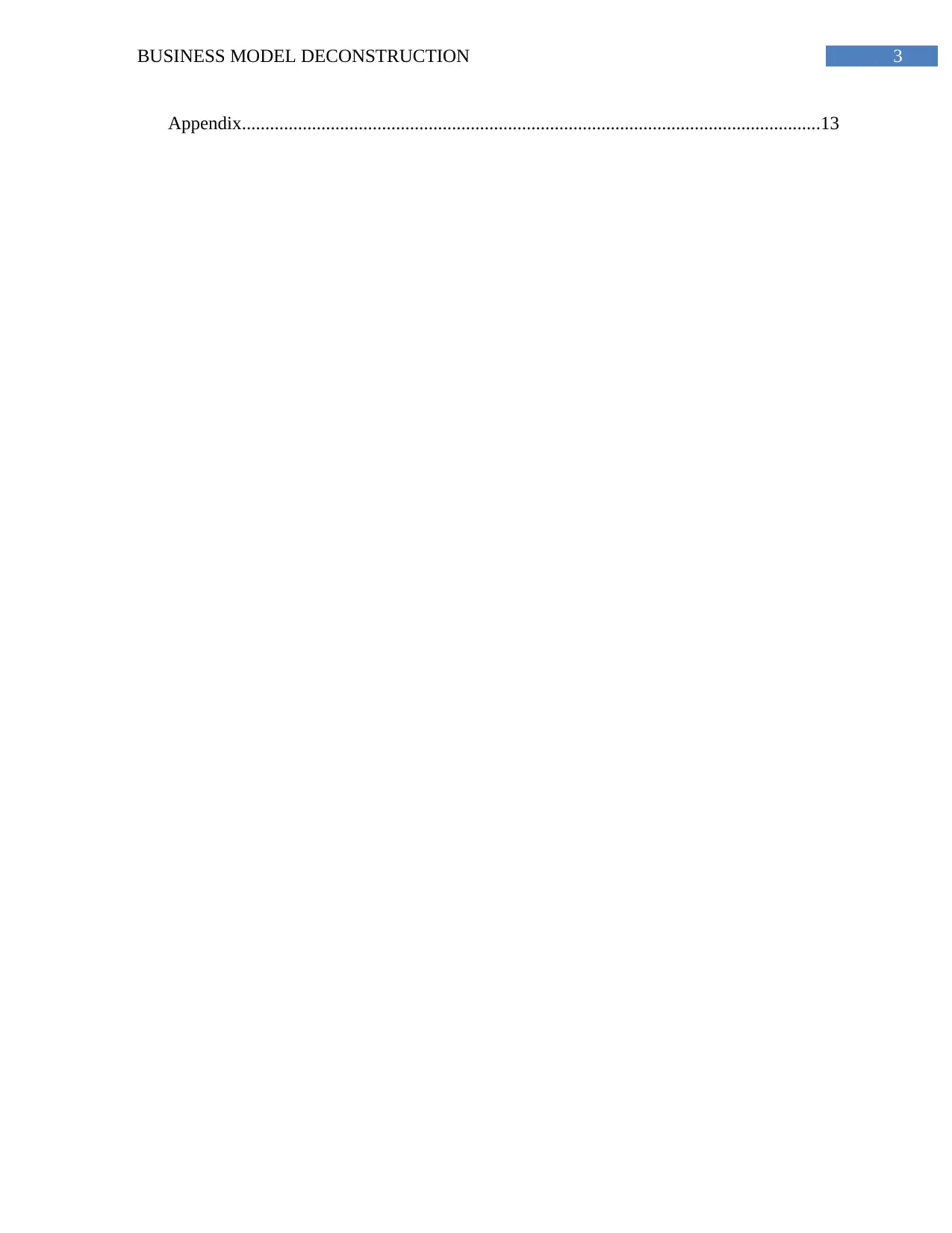
3BUSINESS MODEL DECONSTRUCTION
Appendix............................................................................................................................13
Appendix............................................................................................................................13
Paraphrase This Document
Need a fresh take? Get an instant paraphrase of this document with our AI Paraphraser
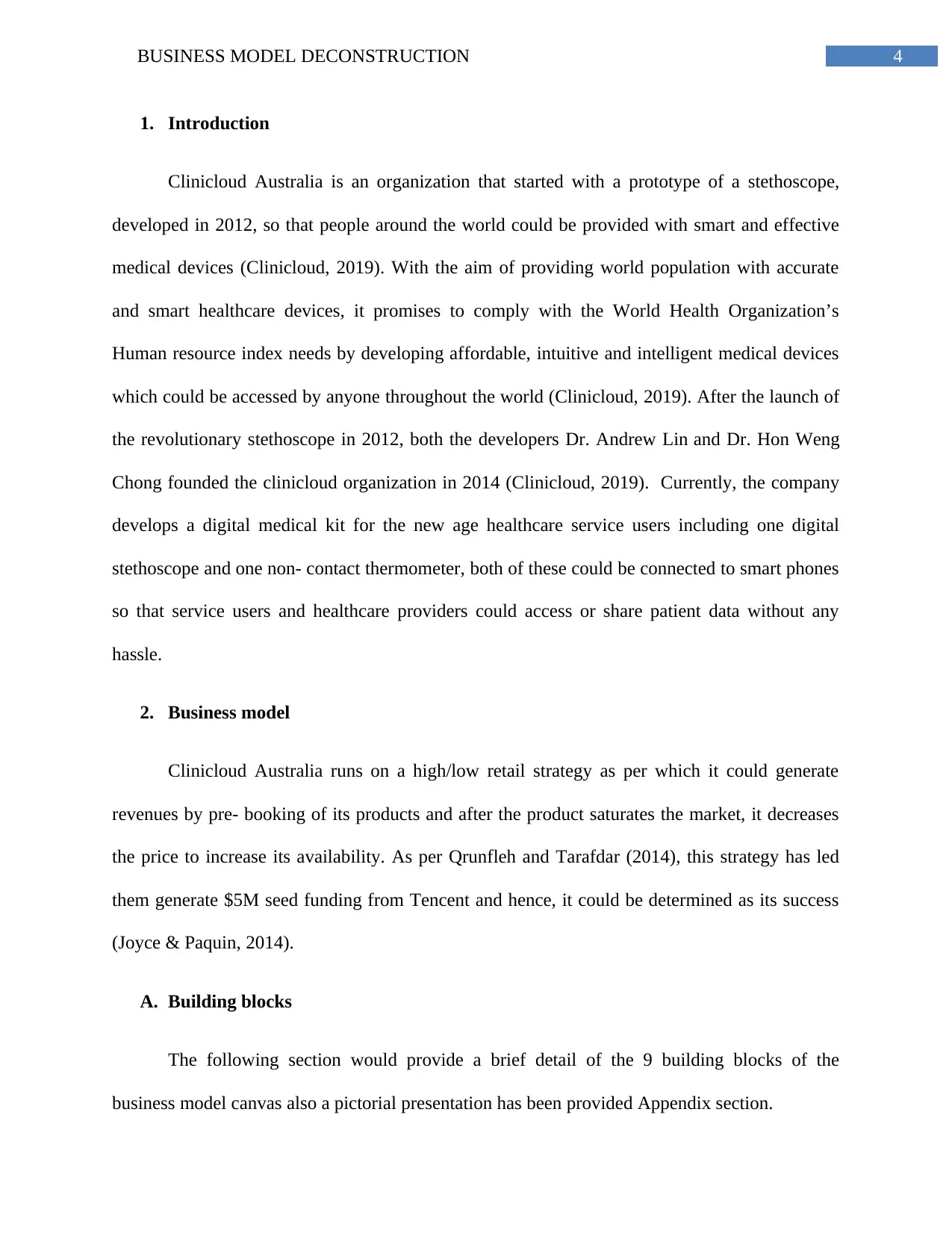
4BUSINESS MODEL DECONSTRUCTION
1. Introduction
Clinicloud Australia is an organization that started with a prototype of a stethoscope,
developed in 2012, so that people around the world could be provided with smart and effective
medical devices (Clinicloud, 2019). With the aim of providing world population with accurate
and smart healthcare devices, it promises to comply with the World Health Organization’s
Human resource index needs by developing affordable, intuitive and intelligent medical devices
which could be accessed by anyone throughout the world (Clinicloud, 2019). After the launch of
the revolutionary stethoscope in 2012, both the developers Dr. Andrew Lin and Dr. Hon Weng
Chong founded the clinicloud organization in 2014 (Clinicloud, 2019). Currently, the company
develops a digital medical kit for the new age healthcare service users including one digital
stethoscope and one non- contact thermometer, both of these could be connected to smart phones
so that service users and healthcare providers could access or share patient data without any
hassle.
2. Business model
Clinicloud Australia runs on a high/low retail strategy as per which it could generate
revenues by pre- booking of its products and after the product saturates the market, it decreases
the price to increase its availability. As per Qrunfleh and Tarafdar (2014), this strategy has led
them generate $5M seed funding from Tencent and hence, it could be determined as its success
(Joyce & Paquin, 2014).
A. Building blocks
The following section would provide a brief detail of the 9 building blocks of the
business model canvas also a pictorial presentation has been provided Appendix section.
1. Introduction
Clinicloud Australia is an organization that started with a prototype of a stethoscope,
developed in 2012, so that people around the world could be provided with smart and effective
medical devices (Clinicloud, 2019). With the aim of providing world population with accurate
and smart healthcare devices, it promises to comply with the World Health Organization’s
Human resource index needs by developing affordable, intuitive and intelligent medical devices
which could be accessed by anyone throughout the world (Clinicloud, 2019). After the launch of
the revolutionary stethoscope in 2012, both the developers Dr. Andrew Lin and Dr. Hon Weng
Chong founded the clinicloud organization in 2014 (Clinicloud, 2019). Currently, the company
develops a digital medical kit for the new age healthcare service users including one digital
stethoscope and one non- contact thermometer, both of these could be connected to smart phones
so that service users and healthcare providers could access or share patient data without any
hassle.
2. Business model
Clinicloud Australia runs on a high/low retail strategy as per which it could generate
revenues by pre- booking of its products and after the product saturates the market, it decreases
the price to increase its availability. As per Qrunfleh and Tarafdar (2014), this strategy has led
them generate $5M seed funding from Tencent and hence, it could be determined as its success
(Joyce & Paquin, 2014).
A. Building blocks
The following section would provide a brief detail of the 9 building blocks of the
business model canvas also a pictorial presentation has been provided Appendix section.
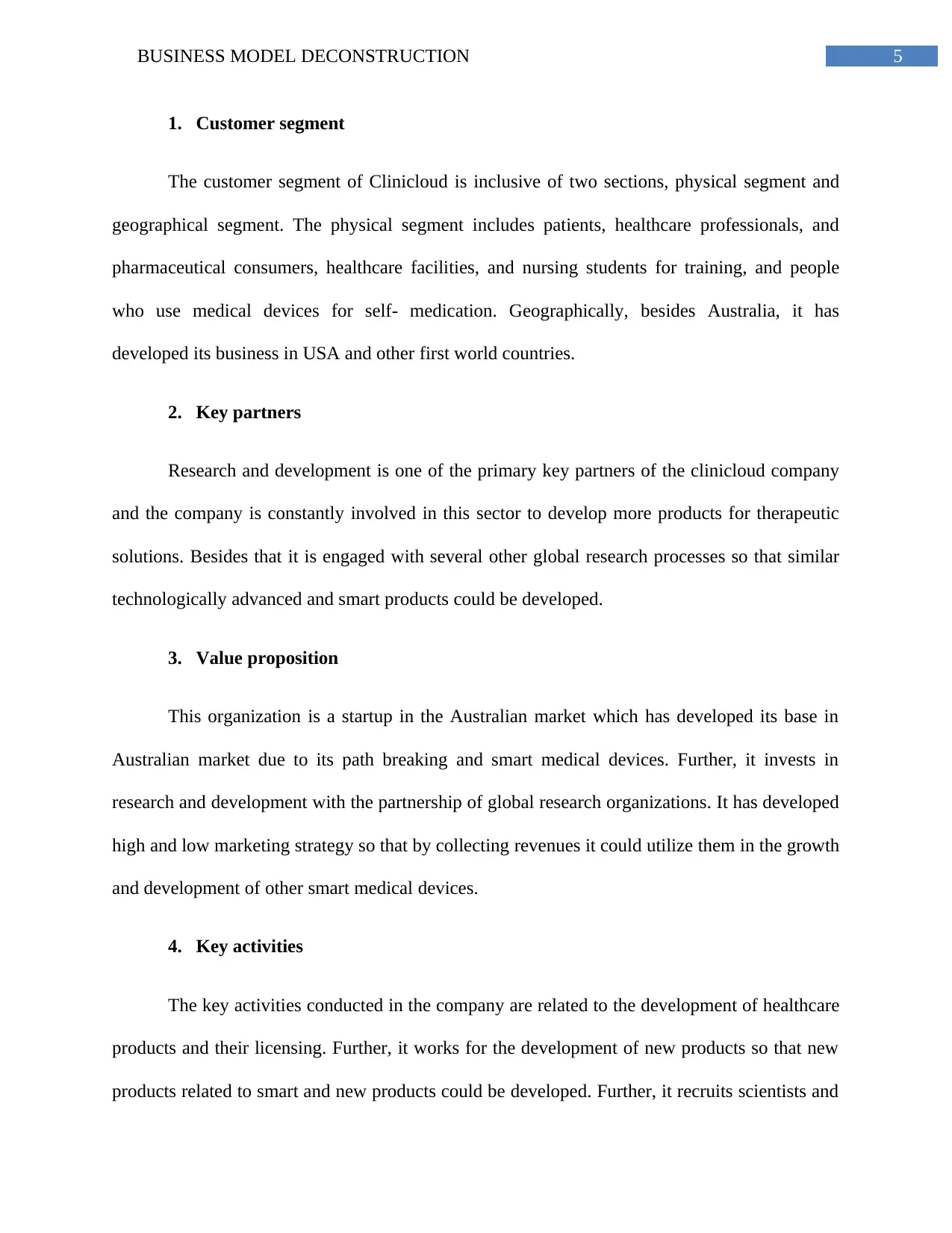
5BUSINESS MODEL DECONSTRUCTION
1. Customer segment
The customer segment of Clinicloud is inclusive of two sections, physical segment and
geographical segment. The physical segment includes patients, healthcare professionals, and
pharmaceutical consumers, healthcare facilities, and nursing students for training, and people
who use medical devices for self- medication. Geographically, besides Australia, it has
developed its business in USA and other first world countries.
2. Key partners
Research and development is one of the primary key partners of the clinicloud company
and the company is constantly involved in this sector to develop more products for therapeutic
solutions. Besides that it is engaged with several other global research processes so that similar
technologically advanced and smart products could be developed.
3. Value proposition
This organization is a startup in the Australian market which has developed its base in
Australian market due to its path breaking and smart medical devices. Further, it invests in
research and development with the partnership of global research organizations. It has developed
high and low marketing strategy so that by collecting revenues it could utilize them in the growth
and development of other smart medical devices.
4. Key activities
The key activities conducted in the company are related to the development of healthcare
products and their licensing. Further, it works for the development of new products so that new
products related to smart and new products could be developed. Further, it recruits scientists and
1. Customer segment
The customer segment of Clinicloud is inclusive of two sections, physical segment and
geographical segment. The physical segment includes patients, healthcare professionals, and
pharmaceutical consumers, healthcare facilities, and nursing students for training, and people
who use medical devices for self- medication. Geographically, besides Australia, it has
developed its business in USA and other first world countries.
2. Key partners
Research and development is one of the primary key partners of the clinicloud company
and the company is constantly involved in this sector to develop more products for therapeutic
solutions. Besides that it is engaged with several other global research processes so that similar
technologically advanced and smart products could be developed.
3. Value proposition
This organization is a startup in the Australian market which has developed its base in
Australian market due to its path breaking and smart medical devices. Further, it invests in
research and development with the partnership of global research organizations. It has developed
high and low marketing strategy so that by collecting revenues it could utilize them in the growth
and development of other smart medical devices.
4. Key activities
The key activities conducted in the company are related to the development of healthcare
products and their licensing. Further, it works for the development of new products so that new
products related to smart and new products could be developed. Further, it recruits scientists and
⊘ This is a preview!⊘
Do you want full access?
Subscribe today to unlock all pages.

Trusted by 1+ million students worldwide
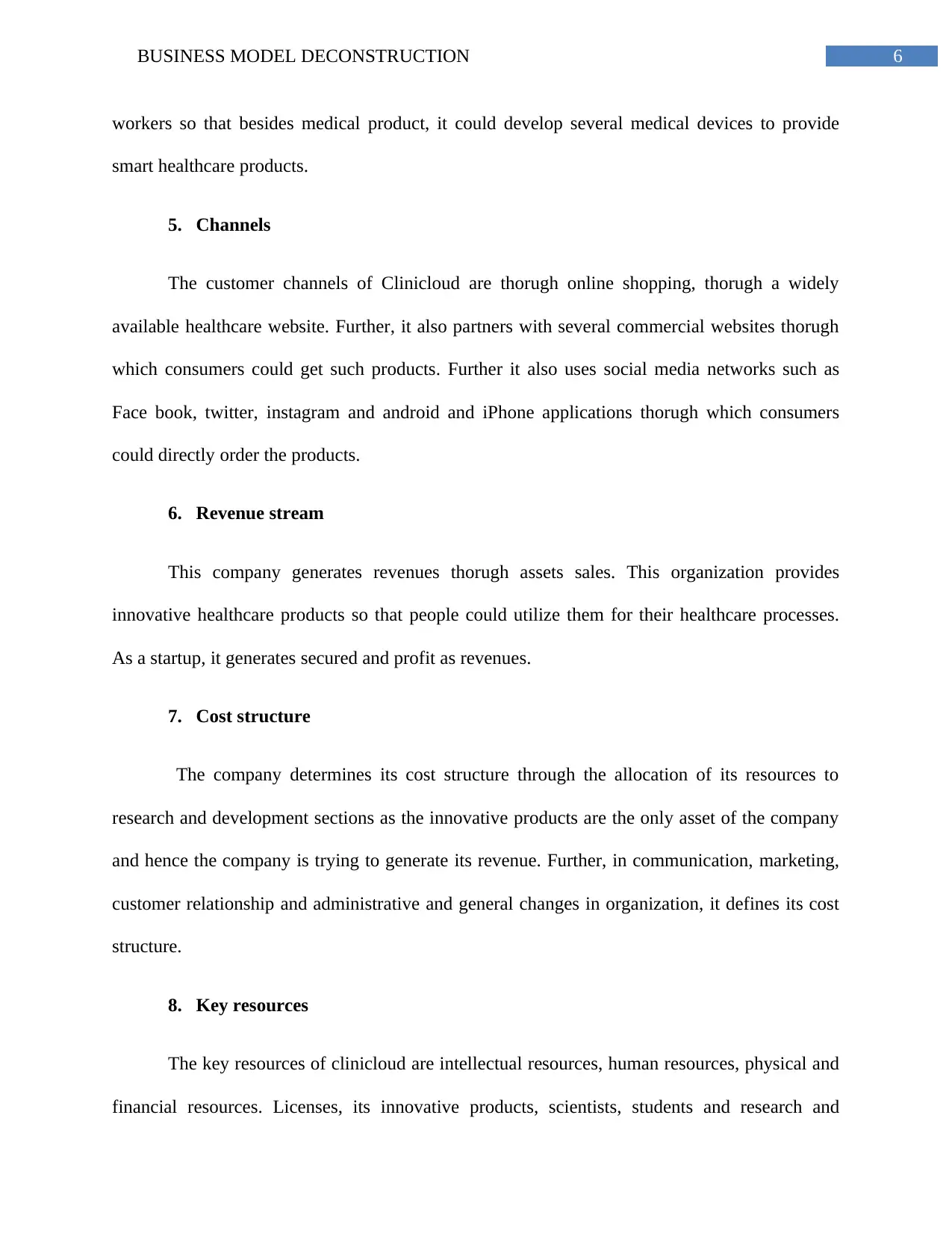
6BUSINESS MODEL DECONSTRUCTION
workers so that besides medical product, it could develop several medical devices to provide
smart healthcare products.
5. Channels
The customer channels of Clinicloud are thorugh online shopping, thorugh a widely
available healthcare website. Further, it also partners with several commercial websites thorugh
which consumers could get such products. Further it also uses social media networks such as
Face book, twitter, instagram and android and iPhone applications thorugh which consumers
could directly order the products.
6. Revenue stream
This company generates revenues thorugh assets sales. This organization provides
innovative healthcare products so that people could utilize them for their healthcare processes.
As a startup, it generates secured and profit as revenues.
7. Cost structure
The company determines its cost structure through the allocation of its resources to
research and development sections as the innovative products are the only asset of the company
and hence the company is trying to generate its revenue. Further, in communication, marketing,
customer relationship and administrative and general changes in organization, it defines its cost
structure.
8. Key resources
The key resources of clinicloud are intellectual resources, human resources, physical and
financial resources. Licenses, its innovative products, scientists, students and research and
workers so that besides medical product, it could develop several medical devices to provide
smart healthcare products.
5. Channels
The customer channels of Clinicloud are thorugh online shopping, thorugh a widely
available healthcare website. Further, it also partners with several commercial websites thorugh
which consumers could get such products. Further it also uses social media networks such as
Face book, twitter, instagram and android and iPhone applications thorugh which consumers
could directly order the products.
6. Revenue stream
This company generates revenues thorugh assets sales. This organization provides
innovative healthcare products so that people could utilize them for their healthcare processes.
As a startup, it generates secured and profit as revenues.
7. Cost structure
The company determines its cost structure through the allocation of its resources to
research and development sections as the innovative products are the only asset of the company
and hence the company is trying to generate its revenue. Further, in communication, marketing,
customer relationship and administrative and general changes in organization, it defines its cost
structure.
8. Key resources
The key resources of clinicloud are intellectual resources, human resources, physical and
financial resources. Licenses, its innovative products, scientists, students and research and
Paraphrase This Document
Need a fresh take? Get an instant paraphrase of this document with our AI Paraphraser
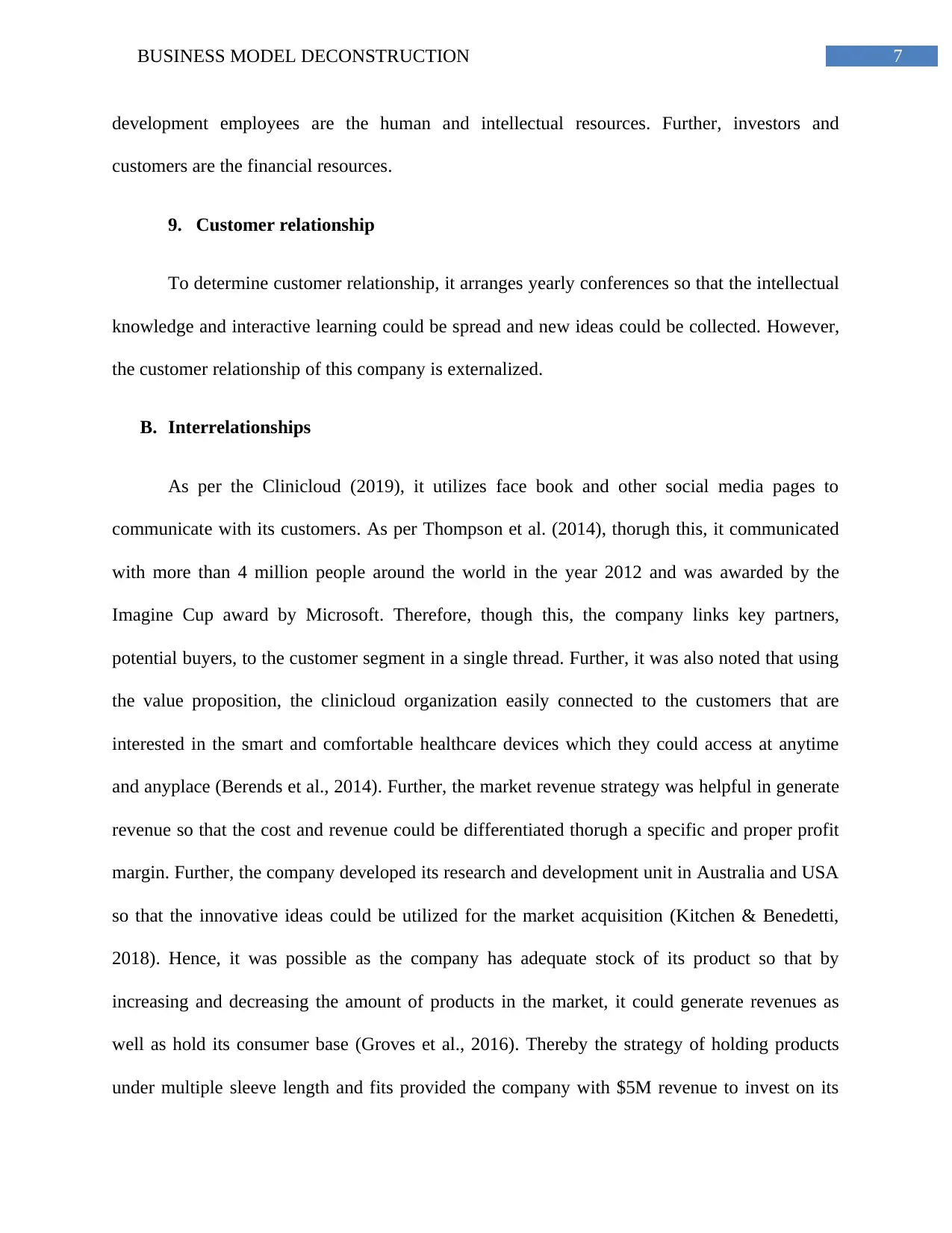
7BUSINESS MODEL DECONSTRUCTION
development employees are the human and intellectual resources. Further, investors and
customers are the financial resources.
9. Customer relationship
To determine customer relationship, it arranges yearly conferences so that the intellectual
knowledge and interactive learning could be spread and new ideas could be collected. However,
the customer relationship of this company is externalized.
B. Interrelationships
As per the Clinicloud (2019), it utilizes face book and other social media pages to
communicate with its customers. As per Thompson et al. (2014), thorugh this, it communicated
with more than 4 million people around the world in the year 2012 and was awarded by the
Imagine Cup award by Microsoft. Therefore, though this, the company links key partners,
potential buyers, to the customer segment in a single thread. Further, it was also noted that using
the value proposition, the clinicloud organization easily connected to the customers that are
interested in the smart and comfortable healthcare devices which they could access at anytime
and anyplace (Berends et al., 2014). Further, the market revenue strategy was helpful in generate
revenue so that the cost and revenue could be differentiated thorugh a specific and proper profit
margin. Further, the company developed its research and development unit in Australia and USA
so that the innovative ideas could be utilized for the market acquisition (Kitchen & Benedetti,
2018). Hence, it was possible as the company has adequate stock of its product so that by
increasing and decreasing the amount of products in the market, it could generate revenues as
well as hold its consumer base (Groves et al., 2016). Thereby the strategy of holding products
under multiple sleeve length and fits provided the company with $5M revenue to invest on its
development employees are the human and intellectual resources. Further, investors and
customers are the financial resources.
9. Customer relationship
To determine customer relationship, it arranges yearly conferences so that the intellectual
knowledge and interactive learning could be spread and new ideas could be collected. However,
the customer relationship of this company is externalized.
B. Interrelationships
As per the Clinicloud (2019), it utilizes face book and other social media pages to
communicate with its customers. As per Thompson et al. (2014), thorugh this, it communicated
with more than 4 million people around the world in the year 2012 and was awarded by the
Imagine Cup award by Microsoft. Therefore, though this, the company links key partners,
potential buyers, to the customer segment in a single thread. Further, it was also noted that using
the value proposition, the clinicloud organization easily connected to the customers that are
interested in the smart and comfortable healthcare devices which they could access at anytime
and anyplace (Berends et al., 2014). Further, the market revenue strategy was helpful in generate
revenue so that the cost and revenue could be differentiated thorugh a specific and proper profit
margin. Further, the company developed its research and development unit in Australia and USA
so that the innovative ideas could be utilized for the market acquisition (Kitchen & Benedetti,
2018). Hence, it was possible as the company has adequate stock of its product so that by
increasing and decreasing the amount of products in the market, it could generate revenues as
well as hold its consumer base (Groves et al., 2016). Thereby the strategy of holding products
under multiple sleeve length and fits provided the company with $5M revenue to invest on its
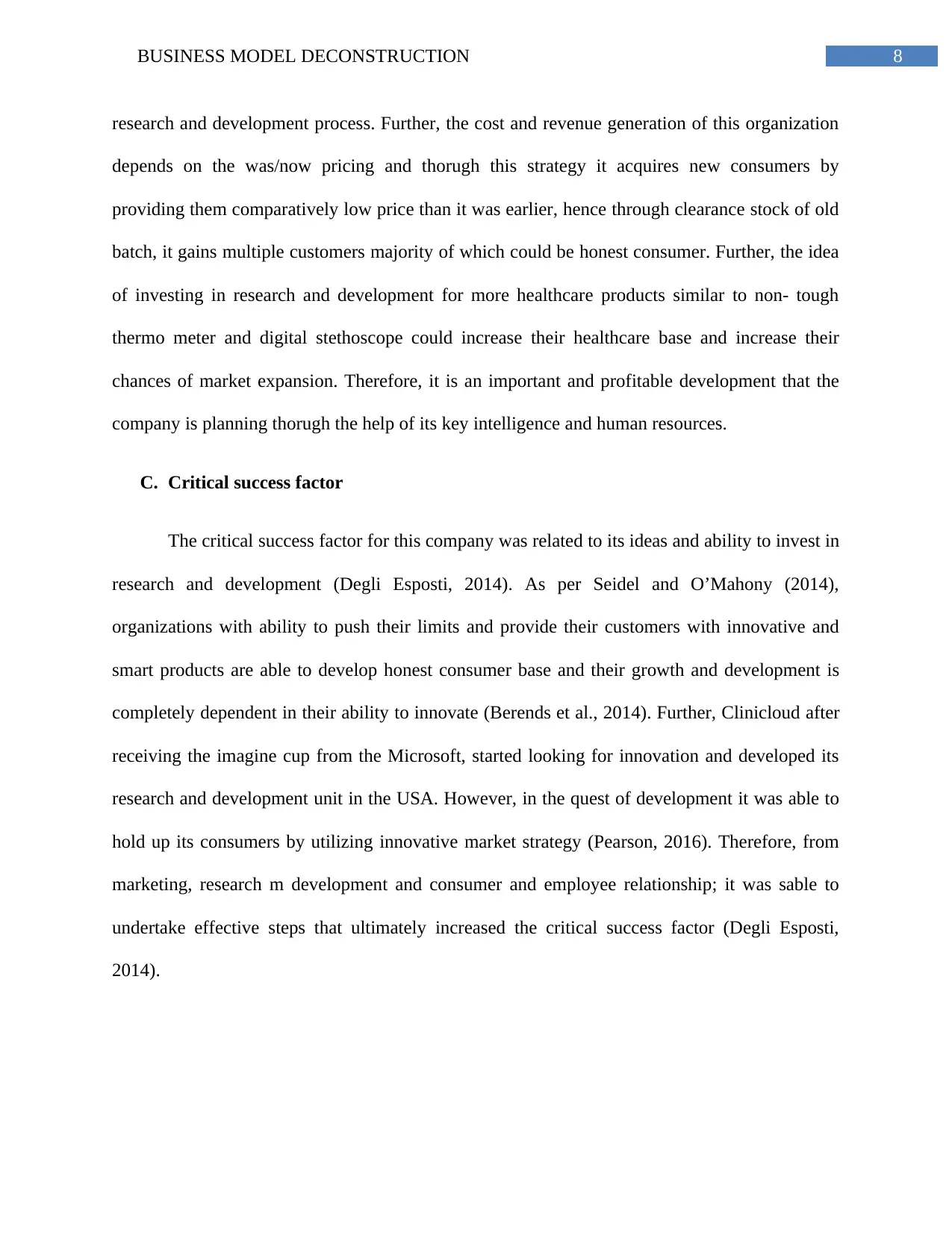
8BUSINESS MODEL DECONSTRUCTION
research and development process. Further, the cost and revenue generation of this organization
depends on the was/now pricing and thorugh this strategy it acquires new consumers by
providing them comparatively low price than it was earlier, hence through clearance stock of old
batch, it gains multiple customers majority of which could be honest consumer. Further, the idea
of investing in research and development for more healthcare products similar to non- tough
thermo meter and digital stethoscope could increase their healthcare base and increase their
chances of market expansion. Therefore, it is an important and profitable development that the
company is planning thorugh the help of its key intelligence and human resources.
C. Critical success factor
The critical success factor for this company was related to its ideas and ability to invest in
research and development (Degli Esposti, 2014). As per Seidel and O’Mahony (2014),
organizations with ability to push their limits and provide their customers with innovative and
smart products are able to develop honest consumer base and their growth and development is
completely dependent in their ability to innovate (Berends et al., 2014). Further, Clinicloud after
receiving the imagine cup from the Microsoft, started looking for innovation and developed its
research and development unit in the USA. However, in the quest of development it was able to
hold up its consumers by utilizing innovative market strategy (Pearson, 2016). Therefore, from
marketing, research m development and consumer and employee relationship; it was sable to
undertake effective steps that ultimately increased the critical success factor (Degli Esposti,
2014).
research and development process. Further, the cost and revenue generation of this organization
depends on the was/now pricing and thorugh this strategy it acquires new consumers by
providing them comparatively low price than it was earlier, hence through clearance stock of old
batch, it gains multiple customers majority of which could be honest consumer. Further, the idea
of investing in research and development for more healthcare products similar to non- tough
thermo meter and digital stethoscope could increase their healthcare base and increase their
chances of market expansion. Therefore, it is an important and profitable development that the
company is planning thorugh the help of its key intelligence and human resources.
C. Critical success factor
The critical success factor for this company was related to its ideas and ability to invest in
research and development (Degli Esposti, 2014). As per Seidel and O’Mahony (2014),
organizations with ability to push their limits and provide their customers with innovative and
smart products are able to develop honest consumer base and their growth and development is
completely dependent in their ability to innovate (Berends et al., 2014). Further, Clinicloud after
receiving the imagine cup from the Microsoft, started looking for innovation and developed its
research and development unit in the USA. However, in the quest of development it was able to
hold up its consumers by utilizing innovative market strategy (Pearson, 2016). Therefore, from
marketing, research m development and consumer and employee relationship; it was sable to
undertake effective steps that ultimately increased the critical success factor (Degli Esposti,
2014).
⊘ This is a preview!⊘
Do you want full access?
Subscribe today to unlock all pages.

Trusted by 1+ million students worldwide
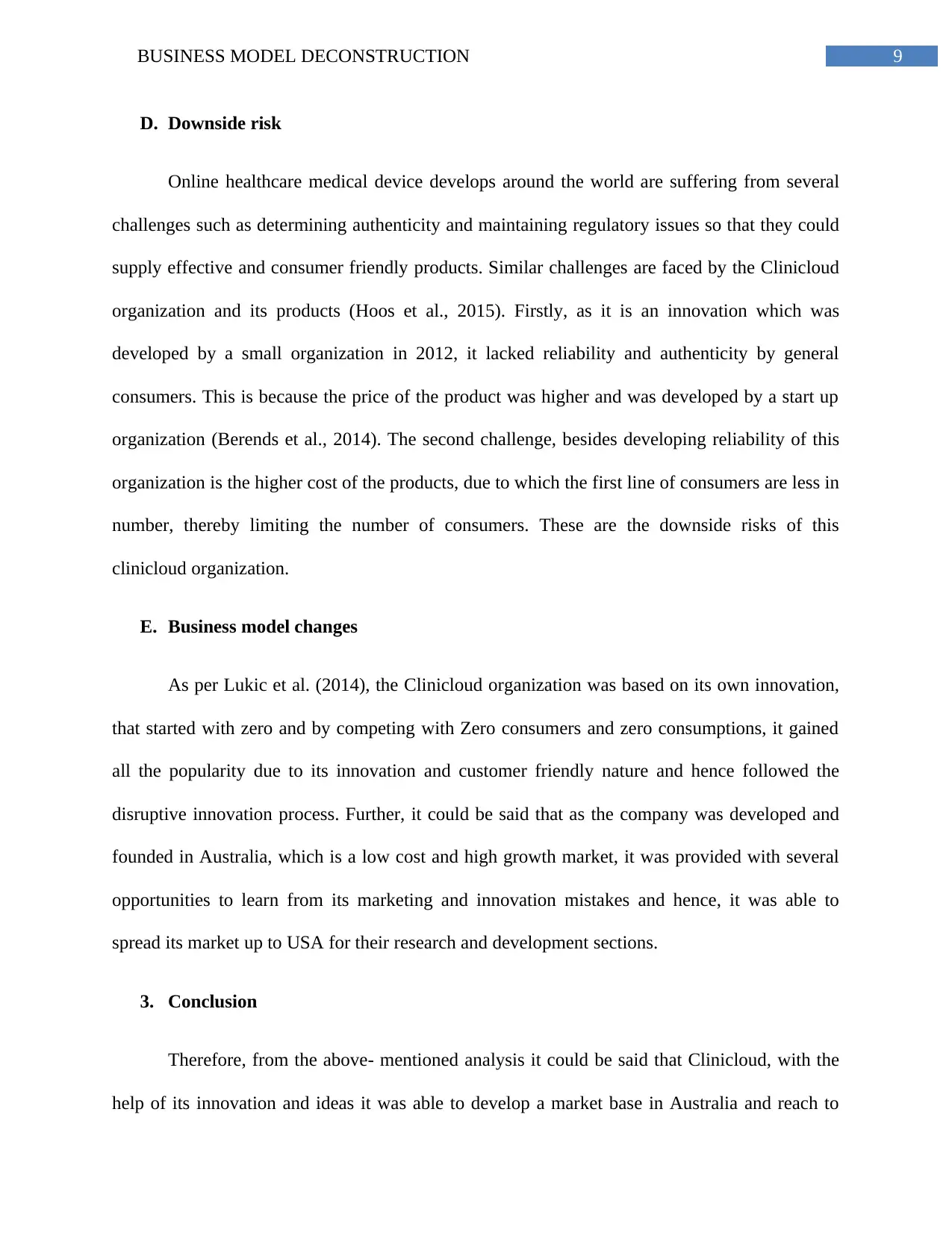
9BUSINESS MODEL DECONSTRUCTION
D. Downside risk
Online healthcare medical device develops around the world are suffering from several
challenges such as determining authenticity and maintaining regulatory issues so that they could
supply effective and consumer friendly products. Similar challenges are faced by the Clinicloud
organization and its products (Hoos et al., 2015). Firstly, as it is an innovation which was
developed by a small organization in 2012, it lacked reliability and authenticity by general
consumers. This is because the price of the product was higher and was developed by a start up
organization (Berends et al., 2014). The second challenge, besides developing reliability of this
organization is the higher cost of the products, due to which the first line of consumers are less in
number, thereby limiting the number of consumers. These are the downside risks of this
clinicloud organization.
E. Business model changes
As per Lukic et al. (2014), the Clinicloud organization was based on its own innovation,
that started with zero and by competing with Zero consumers and zero consumptions, it gained
all the popularity due to its innovation and customer friendly nature and hence followed the
disruptive innovation process. Further, it could be said that as the company was developed and
founded in Australia, which is a low cost and high growth market, it was provided with several
opportunities to learn from its marketing and innovation mistakes and hence, it was able to
spread its market up to USA for their research and development sections.
3. Conclusion
Therefore, from the above- mentioned analysis it could be said that Clinicloud, with the
help of its innovation and ideas it was able to develop a market base in Australia and reach to
D. Downside risk
Online healthcare medical device develops around the world are suffering from several
challenges such as determining authenticity and maintaining regulatory issues so that they could
supply effective and consumer friendly products. Similar challenges are faced by the Clinicloud
organization and its products (Hoos et al., 2015). Firstly, as it is an innovation which was
developed by a small organization in 2012, it lacked reliability and authenticity by general
consumers. This is because the price of the product was higher and was developed by a start up
organization (Berends et al., 2014). The second challenge, besides developing reliability of this
organization is the higher cost of the products, due to which the first line of consumers are less in
number, thereby limiting the number of consumers. These are the downside risks of this
clinicloud organization.
E. Business model changes
As per Lukic et al. (2014), the Clinicloud organization was based on its own innovation,
that started with zero and by competing with Zero consumers and zero consumptions, it gained
all the popularity due to its innovation and customer friendly nature and hence followed the
disruptive innovation process. Further, it could be said that as the company was developed and
founded in Australia, which is a low cost and high growth market, it was provided with several
opportunities to learn from its marketing and innovation mistakes and hence, it was able to
spread its market up to USA for their research and development sections.
3. Conclusion
Therefore, from the above- mentioned analysis it could be said that Clinicloud, with the
help of its innovation and ideas it was able to develop a market base in Australia and reach to
Paraphrase This Document
Need a fresh take? Get an instant paraphrase of this document with our AI Paraphraser
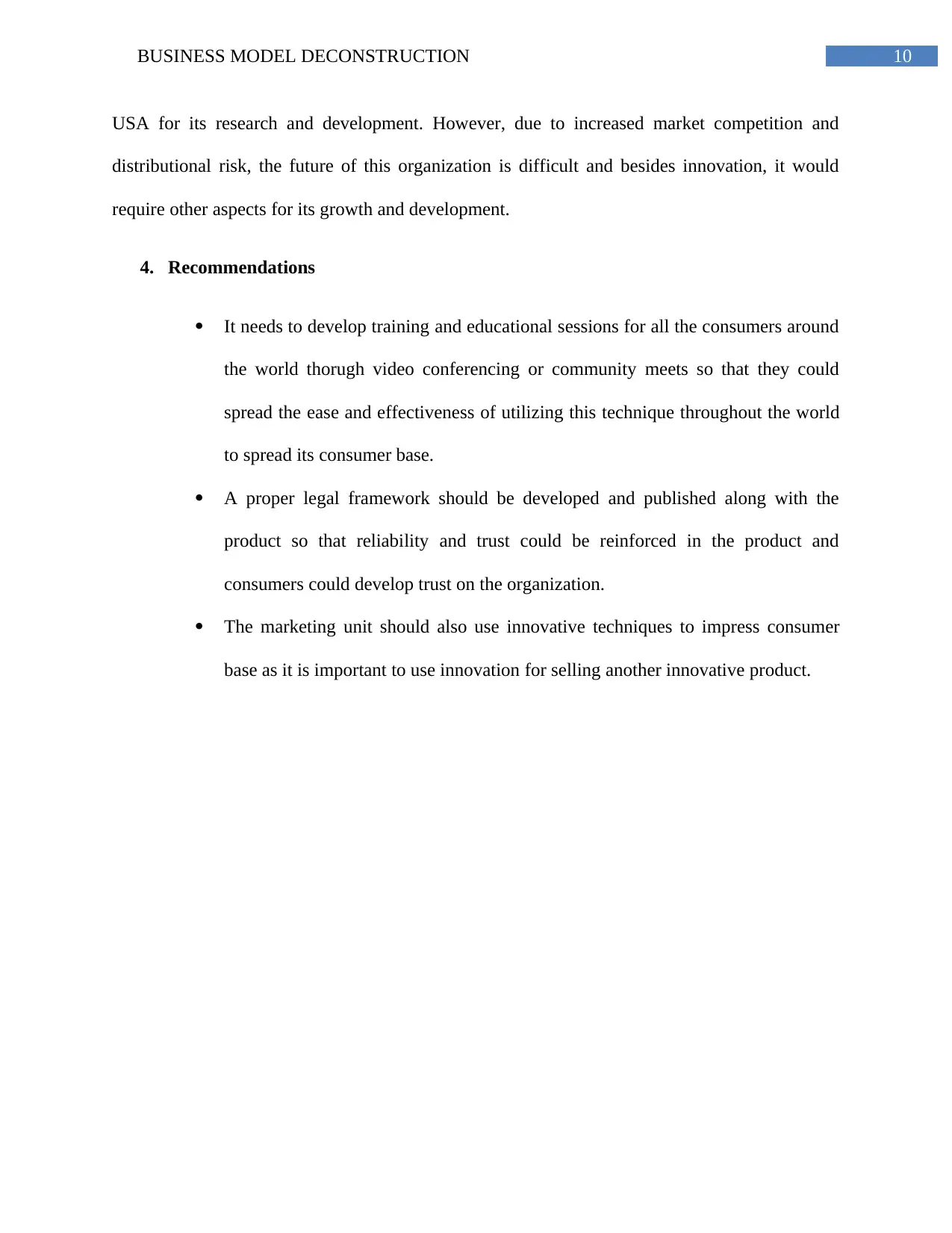
10BUSINESS MODEL DECONSTRUCTION
USA for its research and development. However, due to increased market competition and
distributional risk, the future of this organization is difficult and besides innovation, it would
require other aspects for its growth and development.
4. Recommendations
It needs to develop training and educational sessions for all the consumers around
the world thorugh video conferencing or community meets so that they could
spread the ease and effectiveness of utilizing this technique throughout the world
to spread its consumer base.
A proper legal framework should be developed and published along with the
product so that reliability and trust could be reinforced in the product and
consumers could develop trust on the organization.
The marketing unit should also use innovative techniques to impress consumer
base as it is important to use innovation for selling another innovative product.
USA for its research and development. However, due to increased market competition and
distributional risk, the future of this organization is difficult and besides innovation, it would
require other aspects for its growth and development.
4. Recommendations
It needs to develop training and educational sessions for all the consumers around
the world thorugh video conferencing or community meets so that they could
spread the ease and effectiveness of utilizing this technique throughout the world
to spread its consumer base.
A proper legal framework should be developed and published along with the
product so that reliability and trust could be reinforced in the product and
consumers could develop trust on the organization.
The marketing unit should also use innovative techniques to impress consumer
base as it is important to use innovation for selling another innovative product.
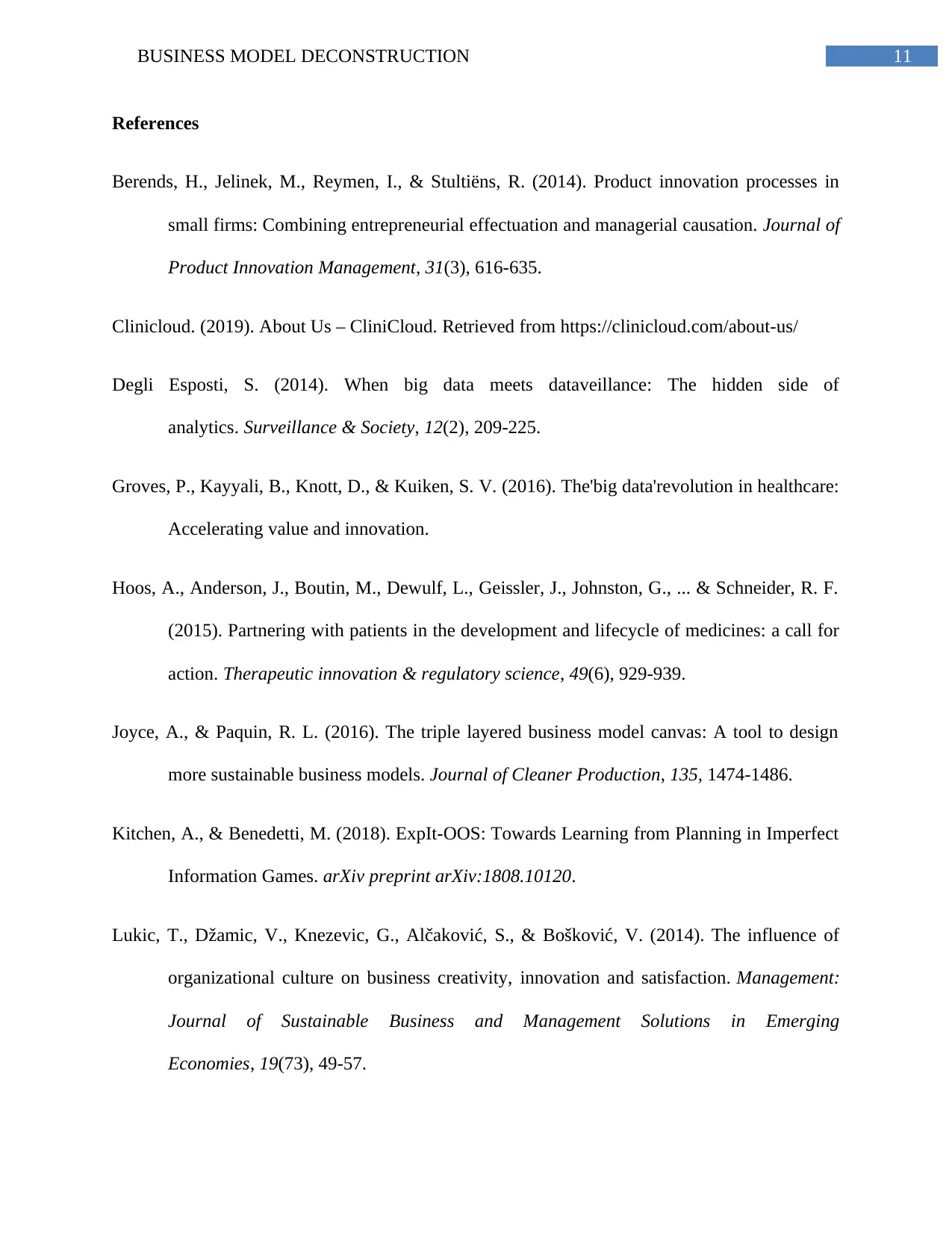
11BUSINESS MODEL DECONSTRUCTION
References
Berends, H., Jelinek, M., Reymen, I., & Stultiëns, R. (2014). Product innovation processes in
small firms: Combining entrepreneurial effectuation and managerial causation. Journal of
Product Innovation Management, 31(3), 616-635.
Clinicloud. (2019). About Us – CliniCloud. Retrieved from https://clinicloud.com/about-us/
Degli Esposti, S. (2014). When big data meets dataveillance: The hidden side of
analytics. Surveillance & Society, 12(2), 209-225.
Groves, P., Kayyali, B., Knott, D., & Kuiken, S. V. (2016). The'big data'revolution in healthcare:
Accelerating value and innovation.
Hoos, A., Anderson, J., Boutin, M., Dewulf, L., Geissler, J., Johnston, G., ... & Schneider, R. F.
(2015). Partnering with patients in the development and lifecycle of medicines: a call for
action. Therapeutic innovation & regulatory science, 49(6), 929-939.
Joyce, A., & Paquin, R. L. (2016). The triple layered business model canvas: A tool to design
more sustainable business models. Journal of Cleaner Production, 135, 1474-1486.
Kitchen, A., & Benedetti, M. (2018). ExpIt-OOS: Towards Learning from Planning in Imperfect
Information Games. arXiv preprint arXiv:1808.10120.
Lukic, T., Džamic, V., Knezevic, G., Alčaković, S., & Bošković, V. (2014). The influence of
organizational culture on business creativity, innovation and satisfaction. Management:
Journal of Sustainable Business and Management Solutions in Emerging
Economies, 19(73), 49-57.
References
Berends, H., Jelinek, M., Reymen, I., & Stultiëns, R. (2014). Product innovation processes in
small firms: Combining entrepreneurial effectuation and managerial causation. Journal of
Product Innovation Management, 31(3), 616-635.
Clinicloud. (2019). About Us – CliniCloud. Retrieved from https://clinicloud.com/about-us/
Degli Esposti, S. (2014). When big data meets dataveillance: The hidden side of
analytics. Surveillance & Society, 12(2), 209-225.
Groves, P., Kayyali, B., Knott, D., & Kuiken, S. V. (2016). The'big data'revolution in healthcare:
Accelerating value and innovation.
Hoos, A., Anderson, J., Boutin, M., Dewulf, L., Geissler, J., Johnston, G., ... & Schneider, R. F.
(2015). Partnering with patients in the development and lifecycle of medicines: a call for
action. Therapeutic innovation & regulatory science, 49(6), 929-939.
Joyce, A., & Paquin, R. L. (2016). The triple layered business model canvas: A tool to design
more sustainable business models. Journal of Cleaner Production, 135, 1474-1486.
Kitchen, A., & Benedetti, M. (2018). ExpIt-OOS: Towards Learning from Planning in Imperfect
Information Games. arXiv preprint arXiv:1808.10120.
Lukic, T., Džamic, V., Knezevic, G., Alčaković, S., & Bošković, V. (2014). The influence of
organizational culture on business creativity, innovation and satisfaction. Management:
Journal of Sustainable Business and Management Solutions in Emerging
Economies, 19(73), 49-57.
⊘ This is a preview!⊘
Do you want full access?
Subscribe today to unlock all pages.

Trusted by 1+ million students worldwide
1 out of 17
Related Documents
Your All-in-One AI-Powered Toolkit for Academic Success.
+13062052269
info@desklib.com
Available 24*7 on WhatsApp / Email
![[object Object]](/_next/static/media/star-bottom.7253800d.svg)
Unlock your academic potential
Copyright © 2020–2025 A2Z Services. All Rights Reserved. Developed and managed by ZUCOL.





